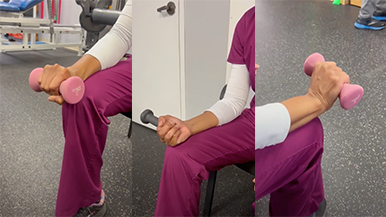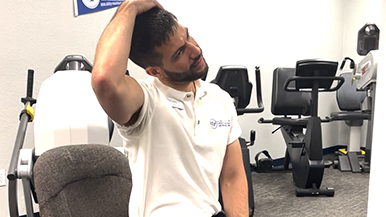Patient Regains Use of Arm After Biceps Tear Surgery
After his biceps tendon repair surgery, Rob’s right arm was in a fragile state; it was locked at the elbow and Rob was fearful of moving it and causing further injury. To reclaim the normal functioning of his arm, he turned to Ability Rehabilitation.
“So far these guys have done a great job,” says Rob. “Mitch is very knowledgeable and is great at explaining what he’s doing and what I should be doing so I can understand it better and improve.”
What Is a Biceps Tendon Tear?
The biceps muscle is found at the front of your upper arm. It attaches to the shoulder and elbow bones by tendons. Biceps tendon tears are commonly caused by a sudden injury and can result in arm weakness and pain when engaging in specific arm movements like the rotation of the forearm.
Many patients can continue functioning with a biceps tendon tear, and may only need simple treatments to relieve their symptoms. If they’re unable to alleviate their symptoms through nonsurgical methods, or they require complete recovery of strength and mobility, surgery to repair the torn tendon may be required.
Biceps tendon tears can be either partial (the tendon is not completely torn) or complete (the tendon splits in two). In many cases, torn tendons begin by fraying. As the damage progresses, the tendon can completely tear, sometimes when lifting a heavy object.
“I tore my bicep,” says Rob. “I had bicep repair surgery done at the elbow and then started coming to Ability Rehabilitation. I had my arm locked at a right angle after the surgery. I was in a splint, and I was very paranoid about just leaving my whole arm limp, and I wouldn’t be tempted to use my bicep at all.”
How Is Biceps Tendon Repair Surgery Performed?

Different procedures are used to reattach the biceps tendon to the elbow including:
- A surgeon uses one incision at the front or the inside part of the elbow
- A surgeon employs small incisions at both the front and back of the elbow
The biceps tendon may be attached by stitches through holes drilled in the forearm bone. Alternatively, tiny metal implants known as suture anchors are used to join the tendon to the bone.
Recovery After Biceps Tendon Repair Surgery
After surgery, the arm may be supported in a splint or elbow brace for four to six weeks, and then patients may need to be in a sling for about a week. The arm may be swollen and painful at first, but those symptoms usually subside gradually day by day.
Surgeons are quick to point out to their patients that surgery is only the first step on the path back to full health, recovery, and functioning. Physical therapy and post-surgical care are often called upon to maximize the results of biceps repair surgery and offer patients the best chance for a complete recovery. Rehabilitation typically starts four to six weeks after surgery or whenever the splint is removed.
Rob and the staff at Ability Rehabilitation wasted no time in beginning his rehabilitation as soon as he was cleared to do so by his surgeon. “This is my second week of working with Mitch, and after my second visit, we got my arm almost completely straight,” says Rob. “I told him on my first visit I was going to do whatever he tells me to do and that I wanted to get better. I’m pretty much doing that, and I trust him. An important thing is just allowing my arm to be straight. So around the house, I’ll take the brace off and just let it hang down and use gravity.”
Experienced and Licensed Professionals Make All the Difference

For Rob, the decision to have surgery was a life-saver, and he wholehearted endorses the process he underwent at Ability Rehabilitation to anyone in his position.
“If anyone is worried about legitimately being hurt, then go and see somebody to make sure because you could always make it worse,” he says. “For me, I pretty much knew immediately that my bicep was messed up. I wanted to do whatever I could to put it back together.”
“I had a surgery a week after I hurt myself. I never had rehab before, but the Ability staff is knowledgeable and nice, and it’s working so far.”



